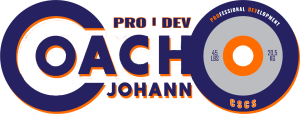Welcome!
In order for you to coaches your friends, family or trainees, coaches, we must prepare to help change habits.
Fitness goal setting is about habits rather than the exact menu to eat from and the exact type of workout our trainees perform. Habits govern both these actions.
When we engage in a program of change – nutrition and eating habit change – we perform this assessment of ABC’s before the action phase.
A = Trigger or Antecedent
B = the resulting action or Behavior
C = the feeling you get or Consequence
Triggers include the events from the outside world. This, while different, is never going to change in occurrence. There will always be trigger.
That trigger forces your action – eating too much, too little, like crap or skipping altogether.
Last, the feeling is improved, denounced or maintained. This is the most glaring sign of a shift in action or a certain type of action that should be taken.
Ask great questions and learn when to engage in analyzing the ABC’s.
Stewart, E. PhD, and Chester Fox, MD, Encouraging Patients to Change Unhealthy Behaviors With Motivational Interviewing Fam Pract Manag. 2011 May-June;18(3):21-25.
- Coaches, online and in-personal personal trainers
- Strength & Conditioning Coaches
- Nutrition coaches, dieticians
- Pilates, movement specialists & yoga instructors
- Sport coaches – collegiate and professional
- Fitness bloggers
- Combat sport trainers and coaches
This course is 1 hour. It includes:
- 3 downloadable pdf handouts
- 1080p video access can be viewed on all your devices as on-demand
- Requires a quiz
- Has a 10 day-money back guarantee
- Leaving reviews & feedback is not required but welcome!
- CEU’s, CEC’s and CE’s (contact hours)
- And, all fitness organizations will honor courses like this via write-in explanation.
[/vc_toggle][vc_toggle title=”Objectives & Goals” el_id=”1602301141357-6deeca50-29cf”]After completing this course,, students and coaches are able to do the following, immediately:
- Deconstruct any meal plan or diet’s core purpose
- Describe the process of specific habit change in three steps
- Present an alternative habit to existing and limiting habits
- Raise nutrition awareness
[vc_column_text]Let’s look at how lifestyle factors have deep inroads into the way your trainees eat.
We need to make sure that the (A)ntecedents are not controlled – this is an impossible ask. But, to proactively make sure those triggers take little effect on eating habits.
There are also so many outside influences that should not totally interfere with positive eating.
The most effective triggers for most people I see over my 17 years might be:
- Salty mood
- Stress and workload
- Hunger interpretation
- Chemical dependency
- BOREDOM
We also should take stock of the best ways to identify hunger.
Shifting the way your eat has everything to do with your ACTIONS off course.
So much of those actions is cemented as positive reinforced behaviors – and a response to Triggers – when we are little. When we are kids, we eat what our parent prepare with little choice in the matter, trusting intuitively that are parents are ensuring love and survival.
The manner in which nutrition was prepared as kids informs our desire to eat as adults. Of course, as adults, we have triggers to thank.
CBT and our practice actually makes choosing smart foods an easier task.
Eating – surprise, surprise – is essential And one of the first actions your trainees can make will hinge on the first meal of the day.
Primarily, whether or not they ate is a quality first inquiry. After that, you need to ask quality questions to discover intel about trainees’ habits. Also, this helps keep your trainees aware.
Choose to feeling amazing all the time.
Guilt surrounding food is real and affects so many different types of people and eaters. Really, feeling awesome after you eat if based on the food your trainees chose to consume. And they get to make a decision for effectiveness and health or otherwise mediocrity and ill-health.
I’ve seen the toughest of the tough feel especially guilty and shove plates of cookies in my face to thwart their incessant cravings.
According to many studies like this one here, there are foods that instill happiness and foods that don’t!
It confirms veggies and sweets make you feel the best, relatively compared to fish and salty treats! That’s amazing.
And, it goes right along with what we think about diets and the foods which those awful diet tell your trainees to eat – they might be “sadder” foods.
Wahl, Deborah et al., 2017. “Healthy food choices are happy food choices: Evidence from a real life sample using smartphone based assessments” Sci Rep. 2017; 7: 17069
Jaegar, Sara and Betina Piqueras-Fiszman, 2016. “The Incidental Influence of Memories of Past Eating Occasions on Consumers’ Emotional Responses to Food and Food-Related Behaviors” Front Psychol. 2016; 7: 943.
Consider the Transtheoretical Model for changing food habits.
- Precontemplation
- Contemplation
- Preparation
- Action
- Maintenance
At the 3 stage, most of your trainees in the future will see you. Here’s where they are ready to gather information with the full intent to take action on it.
- Trainees will not have the awareness to change yet. Most will still eat in a manner which causes them lethargy or poor workouts, even weight gain, but will not see change as viable.
- Trainees will still keep the same actions – eating processed foods which don’t help fitness for example. Except, they will begin to see the need for change and see the pros.
- Preparation, trainees will begin to ask questions about meal plans over diets, or inquire why those diets don’t work. They will shop for new foods and change workouts.
- Action stages, trainees will actively work behind your interventions and skill-building tactics.
- Maintenance is the stage trainee will be in for the rest of their lives – eating salubrious foods and maintaining a high fitness output to support the meal plan strategies.
